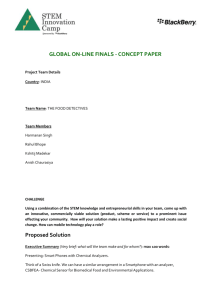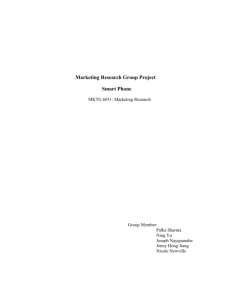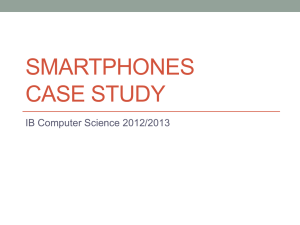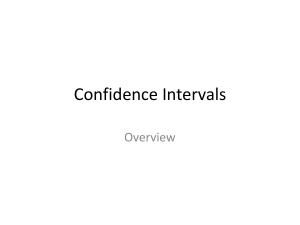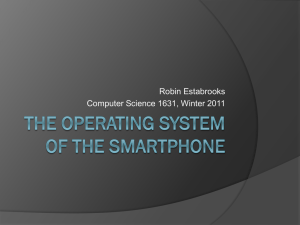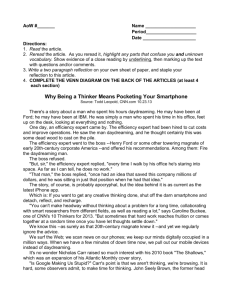zBoost Solves Your Smartphone Problems
advertisement
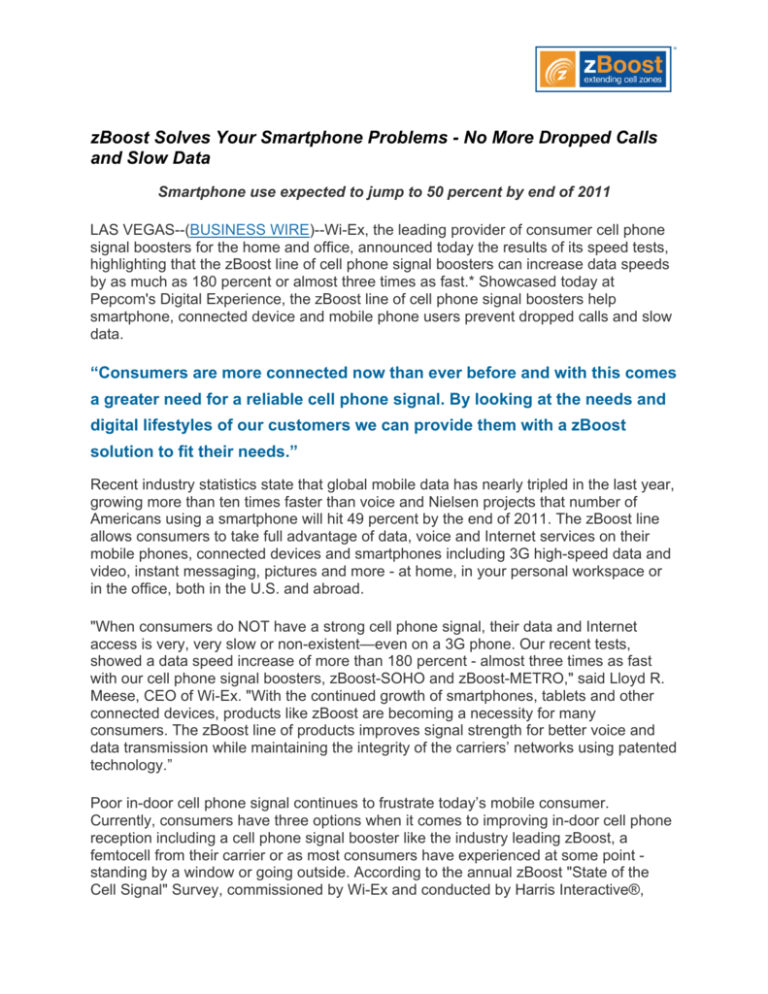
zBoost Solves Your Smartphone Problems - No More Dropped Calls and Slow Data Smartphone use expected to jump to 50 percent by end of 2011 LAS VEGAS--(BUSINESS WIRE)--Wi-Ex, the leading provider of consumer cell phone signal boosters for the home and office, announced today the results of its speed tests, highlighting that the zBoost line of cell phone signal boosters can increase data speeds by as much as 180 percent or almost three times as fast.* Showcased today at Pepcom's Digital Experience, the zBoost line of cell phone signal boosters help smartphone, connected device and mobile phone users prevent dropped calls and slow data. “Consumers are more connected now than ever before and with this comes a greater need for a reliable cell phone signal. By looking at the needs and digital lifestyles of our customers we can provide them with a zBoost solution to fit their needs.” Recent industry statistics state that global mobile data has nearly tripled in the last year, growing more than ten times faster than voice and Nielsen projects that number of Americans using a smartphone will hit 49 percent by the end of 2011. The zBoost line allows consumers to take full advantage of data, voice and Internet services on their mobile phones, connected devices and smartphones including 3G high-speed data and video, instant messaging, pictures and more - at home, in your personal workspace or in the office, both in the U.S. and abroad. "When consumers do NOT have a strong cell phone signal, their data and Internet access is very, very slow or non-existent—even on a 3G phone. Our recent tests, showed a data speed increase of more than 180 percent - almost three times as fast with our cell phone signal boosters, zBoost-SOHO and zBoost-METRO," said Lloyd R. Meese, CEO of Wi-Ex. "With the continued growth of smartphones, tablets and other connected devices, products like zBoost are becoming a necessity for many consumers. The zBoost line of products improves signal strength for better voice and data transmission while maintaining the integrity of the carriers’ networks using patented technology.” Poor in-door cell phone signal continues to frustrate today’s mobile consumer. Currently, consumers have three options when it comes to improving in-door cell phone reception including a cell phone signal booster like the industry leading zBoost, a femtocell from their carrier or as most consumers have experienced at some point standing by a window or going outside. According to the annual zBoost "State of the Cell Signal" Survey, commissioned by Wi-Ex and conducted by Harris Interactive®, nearly 70 percent (66 percent) of cell phone owners consider their cell phone their essential voice and/or data communication tool. Connected Consumers "The growth of data is quickly changing the way everyone from the iFamily to the Smartphone Savvy consumer are using their mobile devices," said Sharon Cuppett, WiEx vice-president of marketing and product development. "Consumers are more connected now than ever before and with this comes a greater need for a reliable cell phone signal. By looking at the needs and digital lifestyles of our customers we can provide them with a zBoost solution to fit their needs." Tablet Techie - Americans are taking to the tablet for work and pleasure. More than 75 percent of the 9 million tablet owners use their tablets for browsing the Internet or reading their e-mail, while 58 percent use them for work. Smartphone Savvy - The smartphone is a staple in today's hyperconnected world and by the end of 2011 it is expected that half of Americans will use a smartphone. A third of Americans use these digital Swiss Army knives to keep up with their schedules, check personal and work emails, the weather and stay connected on Facebook and Twitter. iFamily - Teens would rather text than talk and are taking the rest of the family with them. Grandparents and parents are learning to text so they can stay connected. Teens averaged more than 1700 texts per month. iWorker - According to the zBoost "State of the Signal Survey" , 45 percent of teleworkers have cell phone signal trouble while teleworking. Cell phones are essential communication tools for teleworkers and when they don't get signal, it makes work even more work. Wireless Winner - As Generation Y leads the trend of dropping landline phones in favor of cell phones, cell phone signal becomes much more of a necessity rather than a luxury. One in every four households have dropped their landlines and have gone wireless only. About Wi-Ex Wi-Ex (www.wi-ex.com), the leading provider of consumer cell phone signal boosters, developed zBoost, the first consumer-priced signal booster for the small office/home office (SOHO) cell phone market. Wi-Ex manufactures and distributes the zBoost line of cell phone signal extenders for the home, office or car. The zBoost product line works with most carriers in the US and abroad including AT&T, Sprint, Vodaphone, Verizon and T-Mobile. They were awarded a 2007 and 2010 Consumer Electronics Association Innovations Honoree by the Consumer Electronics Association (CEA). They also were selected as a finalist for the 2007 and 2009 CTIA Emerging Technologies (E-Tech) Award. As the leader, zBoost has more awards, more sales and more locations than all their competitors combined. Wi-Ex continues to develop innovative products to meet the demands of an increasingly wireless society by enhancing wireless signals. About the zBoost "State of the Cell Signal Survey: Harris Interactive® fielded the study on behalf of Wi-Ex from December 8 – 10, 2009 via its QuickQuerySM online omnibus service, interviewing a nationwide sample of 2,212 U.S. adults aged 18 years and older of whom 1,869 own a cell phone and 443 are teleworkers. This online survey is not based on a probability sample and therefore no estimate of theoretical sampling error can be calculated. For complete survey methodology, including weighting variables, please contact Deanna Anderson at danderson@aquapr.com. *Wi-Ex ran a series of tests on the zBoost measuring speed and signal strength. These tests were run in August and October on both Sprint(EVDO) and AT&T(HSPDA) with the units on and then off. Average speed with the METRO off was 451.479 Kps and with the Metro on it was 1301.458 Kps. This was an average increase of 849.979 Kps or a 188% increase. Individual results will vary depending upon environmental conditions.


